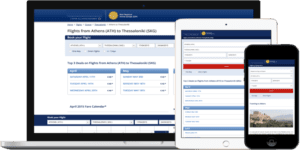As 2016 winds down, the airline industry finds itself fully engaged in a new wave of investment in digital – as opposed to physical – infrastructure. For decades, the world’s top carriers’ marketing budgets were focused on consumer-facing brand awareness and customer recognition. Traditionally, surplus airline funds have been used to add physical capacity which then became expendable as budgets tightened. Airlines now have realized that this type of unsustainable spending can be replaced with spending on sustainable and scalable projects such as digital systems that improve the passenger experience. This migration of the passenger experience online has forced airlines to view their business through the e-commerce lens.
Even while online travel agencies like Expedia and meta-search engines like Kayak built their software businesses around e-commerce best practices, airlines continued their more traditional approach. Now, airlines are beginning to focus their efforts on building best-in-class e-commerce businesses based around these same best practices. There are several examples of airlines focusing on e-commerce strategies as core to their business – easyJet, Jetstar, and more.
But how are airlines approaching their e-commerce strategies? The answer is by focusing on the three distinct steps in the passenger experience or – to address e-commerce – the online booking funnel: Acquire, Engage, Convert. This unique, three-tiered approach helps airlines improve their online marketing performance, grow bookings on their branded websites and earn stronger loyalty from travelers. Here’s how it works:
Acquire
It’s not just about driving as much traffic as possible to an airline’s website – it’s about qualifying that traffic by properly answering a traveler’s intent. For example, if a traveler searches “Flights to Miami,” airlines would want to surface results that accurately reflect this search. This then allows airlines to not only accept qualified traffic into their booking engine, but places that traffic in the correct location to begin driving them towards purchase.
The type of comprehensive digital infrastructure utilized by OTAs – complete with dedicated, device-responsive landing pages for every destination, route, or travel product in a carrier’s inventory in every language and every country – is now necessary for carriers. To compete in today’s online travel search environment, airlines need to implement the same type of platform to quickly and easily merchandise their full product offerings (i.e., flights).
Engage

Engaging, device-responsive pages
How do you then ensure that all of that qualified traffic – that you most likely paid for – actually turns into paying customers? The answer is to engage with travelers effectively by making sure they are able to easily access the information they truly need from airlines – variable route-specific pricing options and associated destination content helping travelers to plan their trip beyond the flight.
The “Engage” step is the all-important “middle-man” in the booking funnel, connecting qualified traffic with the physical product of the customer journey – a flight purchase. Importantly, this engagement needs to happen across devices to ensure this intermediate step is uninterrupted by inconsistencies in an airline’s digital presence in order to maximize end-user engagement. Desktop bookings are no longer the only option to make flight purchases and without mobile-responsive pages, carriers miss the chance for mobile direct bookings.
Convert
Once qualified traffic is acquired and those travelers engaged on an airline’s branded website the focus moves to conversion. The key to sustainable incremental revenue is making sure those travelers complete the booking process. Using existing solutions to create a stronger online marketing infrastructure, the ability already exists for airlines to increase direct channel conversion rates without having to resort to an in-house build. This type of foundation will help to decrease the impact of hefty OTA fees and commissions on their margins.
Simply having infrastructure is not enough to increase conversion rates, though. The platform needs to be leveraged in a way that continues to maintain the velocity of travelers through the booking funnel. Digital infrastructure provides not only a beautiful and seamless UI, but also the amount of data that grants travelers the peace of mind needed to click “Purchase”. Ultimately, this purchase is the conversion – and desired outcome – at the bottom of the booking funnel that airlines strive for.
********
Our goal is to empower airlines with the e-commerce tools needed to drive stronger direct channel performance and reduce their reliance on third-party sites. We refer to it as helping airlines boost their “digital power” in the online marketing landscape. Airlines’ digital power helps them to provide the seamless passenger experience that today’s travelers have come to expect from e-commerce.
To learn more about the Acquire. Engage. Convert approach, contact us here.
